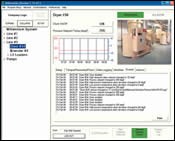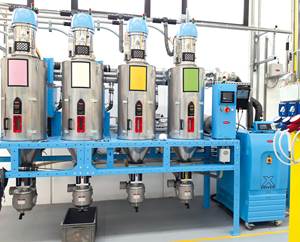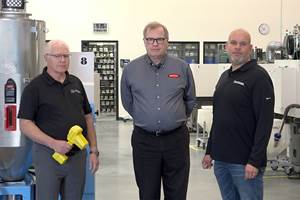To Catch Trouble Early, Put Your Dryers on the Net
In the past, troubleshooting your resin dryer was a fairly straightforward procedure.
In the past, troubleshooting your resin dryer was a fairly straightforward procedure. If there were no visible defects in the finished parts, then there was no need to touch the dryer. If something looked out of line, then checking the heaters with an amp meter or making sure the blowers were rotating and the filters weren’t blocked would solve 95% of all system problems. On the rare occasion that more investigation was re quired, a desiccant test or valve-leakage check would diagnose the problem. Since the dryers themselves were simple, repair was straightforward.
Today, resins and machinery have become more sophisticated (and expensive), making the cost of downtime for unscheduled maintenance and repair less tolerable. With production schedules taking precedence over maintenance, a device needing maintenance or repair is often ignored until complete failure is experienced. Alarms signaling dirty dryer filters or heater burnouts are often silenced or overridden, as long as the product still looks okay.
Today, most processors have instituted preventive maintenance programs for their molding ma chines, but if any attention is given to the auxiliary equipment, it is usually limited to checking the filters and returning the unit to operation as quickly as possible.
There is an imminent need for a more efficient way of tracking and controlling the behavior of process dryers. Available electronic sensing and communications hardware and software can assist in diagnostics and contribute to raising production time and lowering downtime.
Centralize data gathering
The most basic solution to assist in dryer diagnostics is a microprocessor-based control system. This type of control platform can interface with the plantwide control or enterprise computer system. It presents a central information-gathering and recording system that allows the plant manager to visualize dryer performance and address malfunctions. The information available to the control system depends on the connection of the dryer to the SPI communication port on the controls linking it to the host computer system.
A number of suppliers offer proprietary software packages, such as Wonderware, that permit dryer monitoring and can be configured by the user through the operator interface. This is an improvement over the older discrete controls, which lacked the ability to interface with a centralized data system.
Continuing efforts to improve control of drying systems have spawned internet- or intranet-based controls with the capability to provide necessary information to the proper individuals in real time, enabling them to decide when and how to make necessary repairs.
The arrival of computer systems in manufacturing plants has overloaded users with huge volumes of undigested process data. The actual value of that data is only apparent once it has been distilled into a usable form and made available to appropriate personnel for action. The new control and monitoring systems available today offer effective information management on the factory floor—troubleshooting your problems before they shoot you.
Let’s look at a few examples of how this can work:
Example A: trend spotting
PET bottle preform molding is a relatively critical process that requires proper resin drying to succeed. While observing the drying system operation on a computer screen, a maintenance technician at one preform plant noted the heating and cooling trends of the desiccant regeneration system. This enabled the technician to diagnose a leaking valve in the dehumidifier. Because the dewpoint, airflow, and temperature were all well within specifications, there was no need to interrupt the process. However, scheduling preventive maintenance action allowed the staff to have the necessary parts ordered and available to install during the allocated downtime.
Had the problem not been identified in this timely manner, it would have certainly shown up as a loss of dewpoint control at a later time and resulted in a significant interruption of production. The internet-ready control enabled the operator to acquire the data on machine performance and transmit that information directly via e-mail to the manufacturer of the dryer to obtain the correct replacement parts.
Example B: Who’s got mail
In one plant using central control and monitoring of materials handling, if a dryer presents a dewpoint alarm, the control system can be preconfigured to log the fault code, which will in turn generate an e-mail message to the service department of the dryer manufacturer requesting an evaluation of the machine and recommendations for repair. If parts are needed to make the repair, a quote is provided by the vendor’s parts department, listing everything that is needed for the repair.
Example C: A dangerous game
For assistance in diagnosing a host-computer system problem, remote terminal software (such as PC Anywhere) can connect by phone or internet to the problem system. Because the service technician utilizing the software can view remotely the necessary files at the user’s plant, the technician is able to evaluate and even replace corrupted programs or data files while connected over the internet.
This capability came in handy when an operator decided to play unauthorized computer games on the host computer and corrupted the data files being used. A set of files were recreated at the vendor’s office 2000 miles away and then reloaded into the plant system over the internet to rectify the problem. The plant system was back in operation in a few hours, avoiding the cost and delay of a service visit by the technician.
Related Content
Finding Efficiencies in How Components Work Together
Auxiliary systems are vital to the proper functioning of a plastic processing line, and they can be a source of major cost and efficiency improvements.
Read MoreSoftware Helps Processors Make Better Business Decisions
NPE2024: Tracker Monitoring and Reporting Software supports ISO reporting and material validation, including PCR usage and equipment status monitoring.
Read MoreCaptive Molder Beefs Up Auxiliaries to Boost Quality, Consistency
SeeScan adds conveying, drying, feeding and chilling technologies to improve quality — and enhance employee safety — in production of its underground/underwater inspection systems.
Read MoreBlending Specialists ABS Relaunching Thoreson McCosh Dryer Line
NPE2024: Advanced Blending is taking the wraps off reinvigorated Thoreson McCosh drying line.
Read MoreRead Next
Beyond Prototypes: 8 Ways the Plastics Industry Is Using 3D Printing
Plastics processors are finding applications for 3D printing around the plant and across the supply chain. Here are 8 examples to look for at NPE2024.
Read MoreMaking the Circular Economy a Reality
Driven by brand owner demands and new worldwide legislation, the entire supply chain is working toward the shift to circularity, with some evidence the circular economy has already begun.
Read MoreFor PLASTICS' CEO Seaholm, NPE to Shine Light on Sustainability Successes
With advocacy, communication and sustainability as three main pillars, Seaholm leads a trade association to NPE that ‘is more active today than we have ever been.’
Read More















